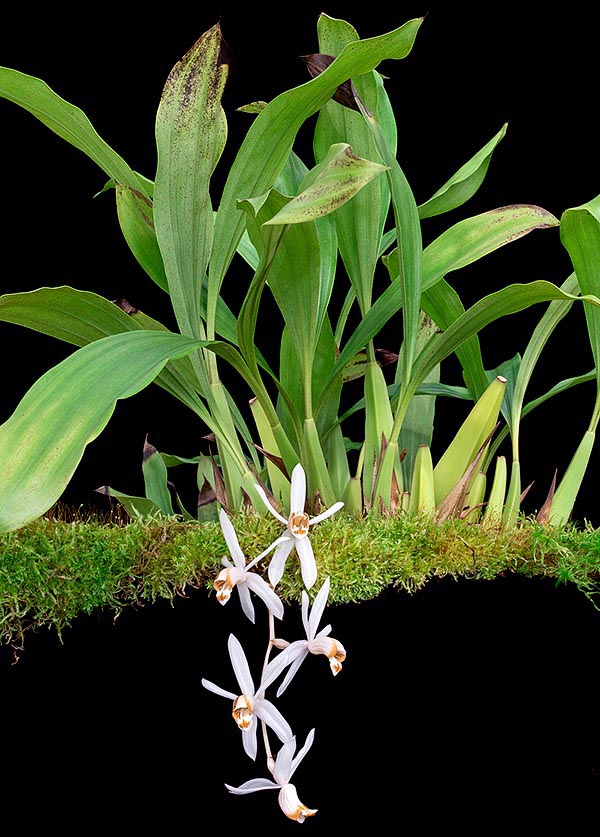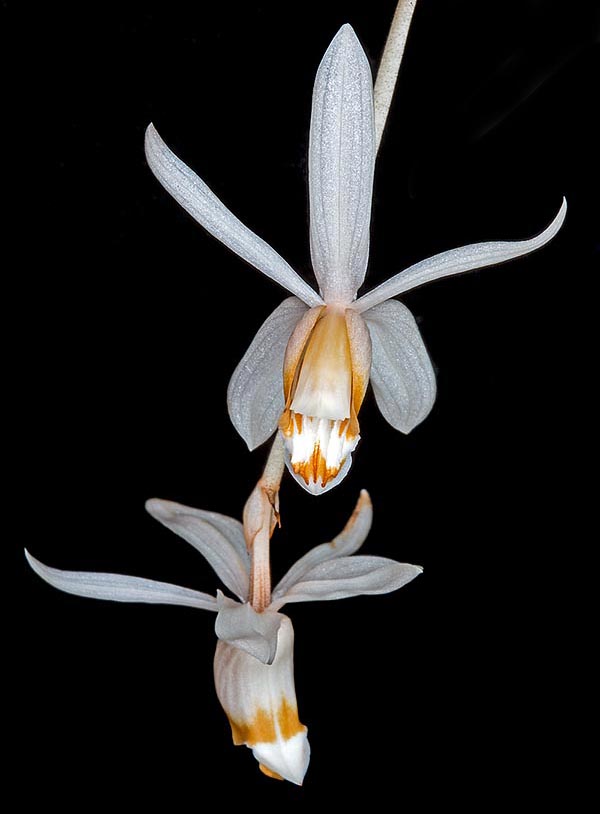Family : Orchidaceae

Text © Pietro Puccio

English translation by Mario Beltramini

The Coelogybe swaniana is native to South-East Asia where grows on calcareous rocks or branches covered by moss. Quadrangular pseudobulbs, 5-12 cm long, with two 10-30 cm leaves at the apex © Giuseppe Mazza
The name of the genus is the combination of the Greek adjective “κοῖλος” (koilos) = hollow and “γυνή” (gyne) = female, withe reference to the concave stigma; the species is honoured to the English painter and sculptor Juhn Macallan Swan (1846-1910).
Common names: white necklace orchid (English).
The Coelogyne swaniana Rolfe (1894) is an epiphytic species with robust creeping rhizome, woody, and quadrangular pseudobulbs, 5-12 cm long and 3-3,5 cm broad, provided at the apex of two elliptical-obovate leaves with acute apex, 10-30 cm long and 3-8 cm broad, with 3-5 prominent veins.
Terminal racemose inflorescences with emerging vegetation, hanging, 10-40 cm long, with 5-15 flowers, on a pedicel and a pubescent ovary 2-3,5 cm long, white or cream white with pale brown veins and spots on the labellum; the flowers, of about 5 cm of diameter, open at the same time and last about 2 weeks.
Almost similar sepals, lanceolate with acute apex, 2,5-3,2 cm long and 0,6-1 cm broad.
Linear-lanceolate petals with acute apex, 2,5-3,2 cm long and 0,4-0,7 cm broad, trilobed labellum, 2,2-3 cm long and 2 cm broad (spread), with erect lateral lobes at the sides of the column, oblong with obtuse apex, and ovate central lobe with curved obtuse apex, run by three keels for all its length, plus two short ones at the apex, and 1,5-2 cm long and 0,5-0,8 cm broad column.

Drooping 10-40 cm racemose inflorescences, with 5-15 flowers reaching the 15 cm © Giuseppe Mazza
Vigourous species particularly appreciated by the orchids passionates due to its elegant inflorescences, requires high luminosity, avoiding the direct sun, for an abundant blooming, medium-high temperatures, 20-30 °C, with lowest night values in winter not under the 16 °C, high humidity, 70-85%, and air in constant movement.
During the growth of the pseudobulbs it is to be watered frequently, taking care to avoid stagnations on the emerging vegetation, easily subject to rottenness, utilizing rain water, demineralized or by reverse osmosis; during the vegetative rest the waterings are to be duly reduced in order to allow the substratum to partially dry up.
For the fertilizations can be used a hydrosoluble balanced product, with microelements, diluted at the 20-25% in respect to the dosage shown on the package, with a fortnightly frequence from spring to autumn, monthly in winter.
Due to the dimensions it can reach, is usually cultivated in pots or baskets, preferably suspended to allow the inflorescences to hang freely, with a compost based on medium sliced bark fragments, sphagnum and inerts to improve the drainage.
The repottings are to be done only when the compost gives signs of deterioration, not loving to be disturbed, at the vegetative restart.
The species is reported in the appendix II of the CITES (species whose trade is internationally ruled).
Synonyms: Coelogyne quadrangularis Ridl. (1897).
→ For general notions about ORCHIDACEAE please click here.
